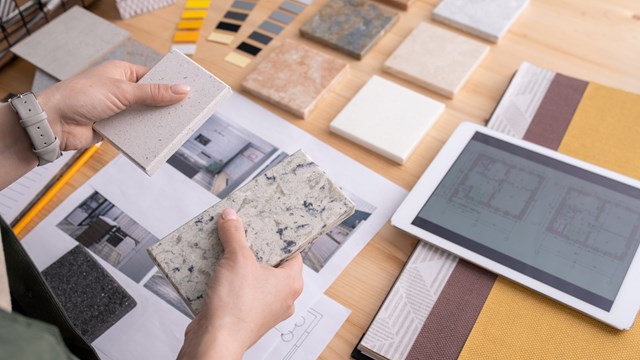There’s a riddle in a popular children’s book that asks, ‘What’s the largest room in the world?’ After much consideration and many incorrect guesses, one of the characters in the book has the answer: “Why, the largest room in the world is room for improvement!”
If you’ve lived in a multifamily community for any amount of time, it’s hard to argue with that statement. A residential building or complex can always stand to be improved, whether with an aesthetic update, design overhaul, or an upgrade of its machinery or systems—but even the most discretionary improvements can open a Pandora’s box of regulatory requirements. Likewise, upgrades intended to make a multifamily building or community code compliant very often force some design and decor decisions—so making a ‘simple’ improvement is often anything but.
Best Laid Plans
With so many variables in play and potential points at which things can go awry with a capital design project, the pros say the best way to ensure that it goes smoothly is to do as much up-front planning and organizing as possible. According to Michael Refat, the Canton, Massachusetts-based Regional Director for national property management company FirstService Residential, that starts with lining up a team of competent professionals to advise on all aspects of the project before it gets going, starting with an engineer.
“We always advise the trustees, before they engage in any kind of renovations, to get a consulting engineer [who can] advise them if the project will trigger code compliance or not,” says Refat. “Usually [clients] think that redesigning the lobby or the hallway is a matter of cosmetics. But when they start the project, they’re confronted with the reality that there is a large added expense to bring the alarm system, the fire suppression system, the sprinkler system, the panels into compliance; otherwise, [the governing body won’t] give the building a certificate of occupancy.”
Refat adds that first and foremost, when a board heads into negotiations with an engineer, they should come to the meeting with a few fundamental facts in hand: first and foremost, the age of the building or community, as well as any capital improvements that have been made already, and when. This information will give the engineer an idea of which codes could be triggered by the work being proposed, which agencies will need to be involved in inspections and approvals, and which elements might be allowed to bypass certain requirements or restrictions because coming into compliance might be logistically or financially impossible.
Refat gives an example of a lobby renovation at one of his buildings that had to comply retroactively with Americans with Disabilities Act (ADA) regulations. “The lobby entrance had a little step that the town wanted removed, because it impeded wheelchair accessibility,” he recalls. “That sounds simple. But in reality, we had to remove the entire flooring from the lobby to where it connected with the sidewalk. So now we had to address the sidewalk, which had landscaping. And we had to address the size of the doors—the width and the height, and what we call the ‘clearance.’ How far will the door open into the lobby? How many seconds should it take to open electronically? Et cetera. Everything we do now in redesigning a lobby or a hallway has become attached to some law.”
Given this complexity, it is important to have a point person—someone who is involved in the project from inception to completion, who can manage the various vendors and agencies and be on site on a regular basis, and who addresses problems or questions when they arise. While these tasks can be assigned to the property manager (and often are), most management contracts stipulate that the client will incur additional fees for such services—sometimes on an hourly basis, sometimes a percentage of the project budget, sometimes a set fee or a combination or charges. Given that most board or committee members do not have the time or the expertise to be engaged in a project on such a granular level, even though it’s an extra line item in the project budget, it pays to hire a specialist: a project manager, an owner’s rep, or a construction manager who will handle everything from acquiring permits to liaising with residents to finding innovative ways to cut costs and create efficiencies over the course of a project.
John Dimaras, COO of New York-based construction management firm EmpireCore, which has clients throughout New York, New Jersey, and Connecticut, notes that the interdependencies involved in most capital projects require a range of knowledge, connections, and strategies. “The value proposition we bring is in our expertise,” he says. “Avoiding the snags, the headaches, the potentially major snafus—and the resulting costs—that can occur on most any project outweighs the expense of hiring a project manager. We are aware of those pitfalls and can preempt them; where they are unavoidable, we can navigate them efficiently and effectively.”
Design By Committee
Once the groundwork—and paperwork—of permits, codes, logistics, and requirements has been laid, then it is time to incorporate the interior designers, decorators, and/or architects. Those interviewed for this article say that the majority of condos and co-ops appoint a design or decorating committee made up of board members, owners/shareholders, or both to do this outreach and to research ideas and choices and make recommendations to the full board.
Gia Milazzo Smith, owner of Designs by Gia, which provides interior design and renovation services to associations throughout New England, says that a problem with this structure is that the ultimate decision-makers should be few, and should be part of the entire process. “From the beginning of a project like this, you have to decide who the decision makers are, and you want those people on board from the first meeting,” she says. When we discuss how frequently boards turn over, not to mention the mercurial makeup of multifamily communities as owners/shareholders come and go, she emphasizes the importance of getting information up front and setting priorities and decisions from the beginning to mitigate the inherent attrition.
“You would start by having a fact-finding meeting,” she says, “to find out what the budget is for the project, what the needs are, how much has already been started—has anything already been purchased or approved? It’s important to ask all the right questions. And you make sure that what you’re designing meets those needs and encompasses all of the decisions that have already been made.”
In terms of who should be on the committee, Milazzo Smith says it’s ideal to have a wide range of stakeholders with a wide range of interests—“not just people that are interested in decor,” she says, “but a wider representation of the needs of the community.”
She continues, “The more people that are involved in the decision, the harder it is to get the decision made. However, everyone wants to feel like they’re being heard. … You might send out a questionnaire, or have a broader meeting to make sure the board or the decorating committee hears everyone’s needs and concerns. People can be passionate about design decisions, whether they know what they’re doing or not. And a space like [a lobby or a hallway], where people walk through every day—it’s an extension of their home, so they’re personally invested in those decisions.”
Often, says Eric Mullendore, owner of Eric Mullendore Architecture & Interior Design based in Chicago, this becomes the biggest challenge for the designer or architect. “I think the difficult thing in terms of design is, in this day and age, the internet makes everybody an expert,” he laments. “Everybody looks on Pinterest, everybody reads design magazines. And that can be a landmine of conflicting interests. Somebody can see a photograph and think, ‘Oh, that’s really neat.’ Well, it’s the wrong size, or it gives off the wrong light [for the space in question]. So from a design perspective, you work with your committee, and you decide which battles are worth fighting, and which battles are not worth fighting.”
Seeing It Through
The professionals agree that as long as all the upfront work has been done correctly—the right team, the permitting, the engineering and technical considerations, the budgeting and financing, the communication with residents—the actual design and construction components of a project are really the easiest parts. However long a capital design project takes—and it can take years from conception to sign-off—the bulk of that duration is in that behind-the-scenes work.
Getting through the construction phase is all about organization, says Mullendore. Everything has to be properly sequenced to minimize disruption to the building or community and to account for “stuff that’s more technical”—like shutting down the sprinkler system, for example. During a hallway renovation project he worked on, he says, “One week, you have demolition on two floors, then the next week, you start painting, and demolition moves down two floors—in other words, a highly organized game of logistics.” Meanwhile, you are “working with a board of directors; you then have to balance that with working with the property manager and the building engineer—and do all this work while people live here. You have to do work between limited hours; you have to put up site protection; you’ve got to work around the residents who still need to come and go. And then you have to deal with the occasional complaints that a neighbor may have—‘Your painting smells,’ or something like that. And the biggest worry is safety.”
“That’s why I think it’s important that the decisions are made in the beginning of the process,” says Milazzo Smith. “You might have approved the design, but it might take a year or two to implement it. If it’s already been approved, then there’s great documentation of that design—what you’re building—and that’s the key. Now, there might be things that come up that you have to address, but you still will be making decisions consistent with the overall design that was created when you started.”
The professional designer’s eye is important in this regard, because they are not only taking into account what looks good now, but what will endure, both aesthetically and physically. “Part of the design process is trying to establish good value,” says Mullendore, “like selecting things that look really good that don’t have to cost a million dollars—and that takes a certain amount of knowledge of product.”
It also takes a certain amount of compromise—and patience. In the hallway project, says Mullendore, “there was no shortage of opinions from unit owners about what was good, and what wasn’t. And so sometimes you just have to sit back and let all those opinions get expressed. And then, hopefully, you [as the designer] thoughtfully make the right decision.”
“I think the most important part of any project is that you listen, and that you give advice,” adds Milazzo Smith. “And that advice is sometimes hard to give; based on my experience with condo associations, giving that tough advice upfront is really helpful. If you’ve set the expectations properly, then every project is successful, because it’s right for the client.”
Darcey Gerstein is Associate Editor and a Staff Writer for CooperatorNews.










Leave a Comment